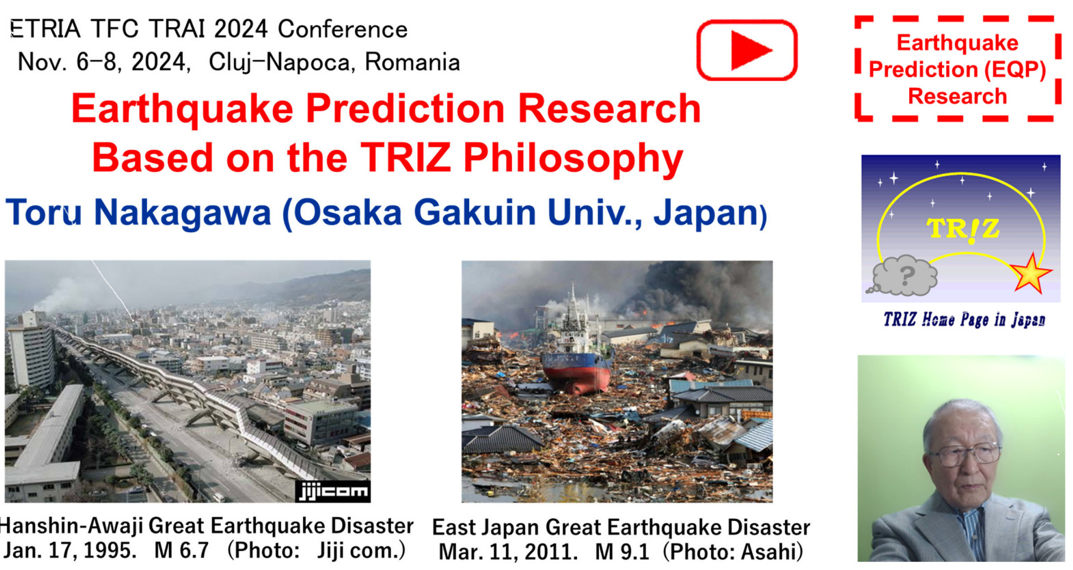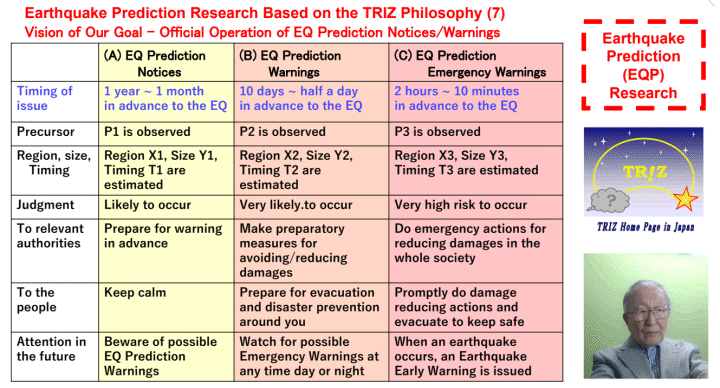Updated: 4 April 2025

Toru Nakagawa (OGU, WTSP Project Leader) "TRIZ Home Page in Japan":
http://www.osaka-gu.ac.jp/php/nakagawa/TRIZ/eTRIZ/
-----------------------------------------------
Hello, how are you?
I am continuing my work to support/promote earthquake prediction
research. I have updated my website “TRIZ Home Page in Japan” yesterday.
https://www.osaka-gu.ac.jp/php/nakagawa/TRIZ/eTRIZ/
Since I want to send information about the progress of EQ
prediction research to people in Japan and the world,
I am trying to translate my articles from Japanese into
English and those in English into Japanese.
This time, I posted the following four sets of articles
in my website:
[1] Paper “Earthquake Prediction Research Based on the TRIZ Philosophy" (Toru Nakagawa)
Presented at ETRIA TFC TRAI2024, Nov. 8, 2024, Romania.
English page (Nov. 26, 2024) Paper, slides and video Japanese page (Mar. 30, 2025) Slides
[2] Introduction “ibid. (6) Paper, Slides, and Video presented at ETRIA TFC TRAI2024"
LinkedIn (TRIZ & Innovation Group) (Jan. 17, 2025)
English page (Feb. 19, 2025) (The top figure is attached.) Japanese page (Mar. 30, 2025)
[3] Paper “Development of Earthquake Prediction Research -
Toward Practical Application (Official Earthquake Prediction Warning)”
Presented at EPSJ (Earthquake Prediction Society of Japan)
Dec. 22, 2024, Chiba University.
Japanese page (Dec. 28, 2024) Paper, slide, and video.
English page (Mar. 29, 2025) Paper and slides - This paper best describes my current thoughts.
[4] Introduction “Earthquake Prediction Research Based on TRIZ
Philosophy (7) Vision of the Ultimate Goal -Official Operation of EQ Prediction Notices/Warnings”
LinkedIn (TRIZ & Innovation Group) (Mar. 28, 2025)
English page (Mar. 30, 2025) Japanese page (Apr. 1, 2025)
This is an introduction to the first part of the paper [3].
Here is the summary of [4]. (The title figure is attached.)
------
The vision of our Goal of EQ Prediction Research is defined as:
"Our goal is to apply our research actually to predict
impending EQs (of damaging size) by observing some EQ
precursors and to announce appropriate warnings on time
before the EQ, officially and publicly toward the people
and society for them to take action to reduce the EQ damage and causality."
At the final state (Stage 5), we will officially issue the EQ
Prediction announcements in 3 stages. they are:
(A) EQ Prediction Notice will be issued from 1 year to 1 month
ahead of the predicted EQ.
(B) EQ Prediction Warning will be issued from 10 days to half a day
ahead of the EQ.
(C) EQ Prediction Emergency Warning will be issued from 2 hours
to 10 minutes ahead of the EQ.
All such announcements are made along the procedure of
(a) detecting some clear precursor events with the estimation
of the region, scale, and timing of EQ (using the technical system),
(b) decision of advice by the panel of experts, and
(c) approval of announcement by the national authority.
The EQ Prediction research (and researchers) is responsible for
establishing reliable methods and a technical system of EQ prediction.
I expect that Kamiyama method will be useful for (A) and
Tsutsui method for (C), but I can find no method for (B) yet at present.
We wish to achieve the goal hopefully in 20 years.
-----------
For example, (A) EQ Prediction Notice may be broadcast as follows:
"This is the official announcement of an EQ Prediction Notice,
issued by the national agency today:
The phenomenon P1 has been observed by the EQ prediction system
and confirmed (by the national panel of experts) as a precursor
event of a possible EQ.
An EQ is likely to occur at the estimated location of region X1
(and its vicinity), with the size of magnitude Y1 (±0.5) and
the timing T1 (e.g., from 3 months to 1 year ahead from now).
Relevant authorities (such as government/local authorities,
disaster prevention organizations, and many others) in the area
(the region X1 and around, widely) are advised to take
precautionary measures (as already set in the EQ disaster
prevention guidelines).
The public in the relevant area is asked to keep calm and
pay attention to possible future EQ prediction warnings.
The Warning announcement will be issued from 10 days to
half a day in advance of the predicted EQ after observing
some clearer precursor event."
ーーー
To make the Earthquake Prediction really applicable as we hope
in our vision, collaborative work by many people having
different background and expertise is absolutely necessary.
We are looking for people who are willing to work in collaboration
with us and to support the EQ Prediction research.
Let's work Together! Connected !!
Best wishes,
Toru
--------------------------
Toru Nakagawa, Dr., Professor Emeritus, Osaka Gakuin University
E-mail: This email address is being protected from spambots. You need JavaScript enabled to view it. [Main email address. For receiving.]
This email address is being protected from spambots. You need JavaScript enabled to view it. [For sending (& receiving)]
This email address is being protected from spambots. You need JavaScript enabled to view it. [For sending Update Announcements] Editor of the "TRIZ Home Page in Japan":
https://www.osaka-gu.ac.jp/php/nakagawa/TRIZ/eTRIZ/">URL:https://www.osaka-gu.ac.jp/php/nakagawa/TRIZ/eTRIZ/
Project Leader of World TRIZ-related Sites Project (WTSP) Director of CrePS Institute:
Publication of "TRIZ Practices and Benefits" book series (in Japanese)
3-1-13 Eirakudai, Kashiwa, Chiba 277-0086, Japan.
Phone & FAX: +81-4-7167-7403
------------------------------------------
- Details
- Category: TRIZ News
Updated: 22 February 2025

Toru Nakagawa (OGU, WTSP Project Leader) "TRIZ Home Page in Japan":
http://www.osaka-gu.ac.jp/php/nakagawa/TRIZ/eTRIZ/
-----------------------------------------------
Hello, how are you?
I uploaded the following two articles yesterday in my website:
https://www.osaka-gu.ac.jp/php/nakagawa/TRIZ/eTRIZ/
[1] My paper presented at EPSJ (Earthquake Prediction Society
of Japan) conference. (held on Dec. 21-22, 2024)
In Japanese: paper, slides, video (on Dec. 28, 2024)
In English: paper (on Feb. 21, 2025)
[2] My LinkedIn article introducing my ETRIA presentation.
In English: LinkedIn article (on Jan. 17, 2025)
In English: in my website (on Feb. 22, 2024)
------------------------------------
[1] Development of Earthquake Prediction Research - Toward
Practical Application (Official Earthquake Prediction Warning)
Toru Nakagawa, EPSJ Conference, Dec. 22, 2024
(I wrote this paper 3 months later than the ETRIA paper.
It is concise (max 6 pages), clearer, and advanced (presented
toward EPSJ members, devoted to Earthquake Prediction Research.)
Abstract:
Research on Earthquake Prediction has long been in a state of
groping in the dark, but we now see a clear ray of light emerging since these 2 years.
Tsutsui observed the electric field deep underground to clearly
capture its fluctuations immediately before and after an earthquake,
and Kamiyama et al. analyzed satellite data on crustal deformation
over time to detect anomalous variations several years to several
months before an earthquake.
Based on these clues, we discuss here ways to develop Earthquake
Prediction Research to the practical application stage.
In the practical application stage, public organizations will
issue Earthquake Prediction notices (1 year to 1 month in advance),
warnings (10 days to 1 day in advance), and emergency warnings
(2 hours to 10 minutes in advance) so that people and society
can take measures to minimize earthquake damage.
To achieve this goal, we will proceed in five stages, i.e.,
development/realization of Earthquake Prediction methods (Stage 1),
verification (Stage 2), large-scale deployment (Stage 3),
establishment of technical systems (Stage 4), and public
operation (Stage 5), while clarifying the tasks for each stage.
At present, we are just entering Stage 2, where several research
groups are working together to validate breakthrough methods.
To manage such research projects, we should better establish
a General Incorporated Foundation as an offshoot of EPSJ.
In Stage 3, a project funded by KAKENHI (the Grant-in-Aid for
Scientific Research) should play the main role, while
in Stage 4, a national project will play the main role.
Assuming that 5 years are needed for each stage, it will take
20 years to achieve the final stage of public operation.
We are determined to move forward with such a great vision
and will.
(Slides in English will appear some time later.)
[2] Earthquake Prediction Research Based on the TRIZ Philosophy:
(6) Paper, Slides, and Video Presented at the ETRIA TRAI
2024 (Nov. 6-8, Romania) Toru Nakagawa, LinkedIn article, Jan. 17, 2025
(This LinkedIn article introduces my ETRIA presentation, and lists the series of my LinkedIn articles (1) to (5).)
Let's work Together! Connected !!
Best wishes,
Toru
--------------------------
Toru Nakagawa, Dr., Professor Emeritus, Osaka Gakuin University
E-mail: This email address is being protected from spambots. You need JavaScript enabled to view it. [Main email address. For receiving.]
This email address is being protected from spambots. You need JavaScript enabled to view it. [For sending (& receiving)]
This email address is being protected from spambots. You need JavaScript enabled to view it. [For sending Update Announcements] Editor of the "TRIZ Home Page in Japan":
https://www.osaka-gu.ac.jp/php/nakagawa/TRIZ/eTRIZ/">URL:https://www.osaka-gu.ac.jp/php/nakagawa/TRIZ/eTRIZ/
Project Leader of World TRIZ-related Sites Project (WTSP) Director of CrePS Institute:
Publication of "TRIZ Practices and Benefits" book series (in Japanese)
3-1-13 Eirakudai, Kashiwa, Chiba 277-0086, Japan.
Phone & FAX: +81-4-7167-7403
------------------------------------------
- Details
- Category: TRIZ News
